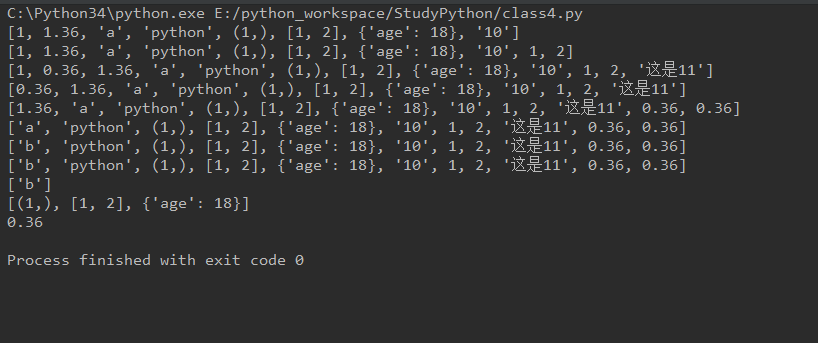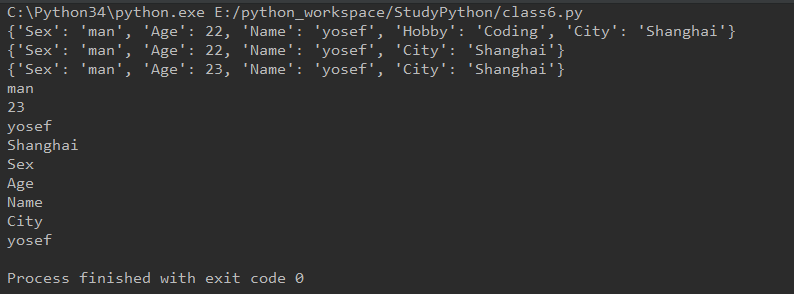python之列表,元組,字典。
阿新 • • 發佈:2018-11-23
在博主學習列表,元組以及字典的時候,經常搞混這三者。因為他們都是用括號表示的。分別是[],(),{}.
列表(list):
[1,'abc',1.26,[1,2,3],(1,2,3),{'age:18'}]
列表中的元素可以是整型,浮點型,字串,也可以是元組,列表,字典。
列表中的元素是有序的,而且元素可以更改,包括增刪改。列表類似於Java之中的陣列。
列表的常用方法:append,extend,remove,insert,pop,sort,reverse。
1 #!/usr/bin/python3 2 # -*- coding: utf-8 -*- 3 # @Time :2018/11/23 13:544 # @Author :yosef 5 # @Email :[email protected] 6 # @File: :class4.py 7 # @Software :PyCharm Community Edition 8 9 list1 = [1, 1.36, 'a', 'python', (1,), [1, 2], {'age': 18}] 10 11 # print(list1) 12 # for i in list1: 13 # print(i) 14 # list1.append("5") # append方法只能在列表的末尾新增一個元素15 16 # 增 append extend insert 17 list1.append("10") # append方法只能在列表的末尾新增一個元素 18 print(list1) 19 20 list1.extend([1, 2]) # extend方法可以連線兩個列表list 21 print(list1) 22 23 list1.insert(1, 0.36) # insert相比append, insert可以插入具體位置,append只能在末尾。 24 list1.insert(13,"這是11") # 當索引位置大於list原本長度,相當於在末尾增加元素 25 # print(len(list1))26 print(list1) 27 28 # 刪 1.python的del 2.list的remove 3. list的pop 29 del list1[0] # del方法可以通過索引直接刪除list之中的某個元素 30 print(list1) 31 32 list1.extend([0.36, 0.36]) 33 list1.remove(0.36) # remove方法是通過傳入的值刪除list中相匹配的第一個元素 34 print(list1) 35 36 list1.pop(0) # pop方法也是通過索引來刪除list中元素,對比del方法,一個是Python自帶,一個是list自帶 37 print(list1) 38 39 # 改 直接通過list索引來修改相應位置的值 40 list1[0] = 'b' 41 print(list1) 42 43 # 查 類似於字串的查 44 print(list1) # 列印list所有元素 45 print(list1[0:1]) # 列印list的第一個元素 46 print(list1[2:5]) # 列印list的第3-5個元素 47 print(list1[-1]) # 列印list的最後一個元素
這是結果:

2. 元組(tuple)
元組有序,且不可修改。
先看這張圖:

我們從編譯器中可以看到,元組只有2個方法,一個是計數另一個是看索引,並不支援增刪改查。
1 #!/usr/bin/python3 2 # -*- coding: utf-8 -*- 3 # @Time :2018/11/23 16:43 4 # @Author :yosef 5 # @Email :[email protected] 6 # @File: :class5.py 7 # @Software :PyCharm Community Edition 8 9 tuple1 = (1, 1.36, 'a', 'python', (1,), [1, 2], {'age': 18}) 10 print(tuple1.count(1)) # 引數計數 11 print(tuple1.index(1.36)) # 元素索引位置
元組內部元素不可修改,但是內部元素的列表,字典可以修改其內部元素。注意,當元組只有一個元素時,要在元素後加上",",否則會當成原本的變數型別處理。
1 tuple2=(1,) 2 tuple3=(1) 3 print(tuple2,tuple3)
結果:
tuple2是元組,tuple3是整型3.
3. 字典(dict)
首先對於字典,我們要知道它與列表元組不同的是,字典是無序的,可以增加修改刪除。字典的對應關係是key: value.
1 #!/usr/bin/python3 2 # -*- coding: utf-8 -*- 3 # @Time :2018/11/23 17:11 4 # @Author :yosef 5 # @Email :[email protected] 6 # @File: :class6.py 7 # @Software :PyCharm Community Edition 8 9 dict1 = {"Name": "yosef", 10 "Sex": "man", 11 "Age": 22, 12 "City": "Shanghai"} 13 14 # 增加 15 dict1["Hobby"] = "Coding" # 不需要呼叫方法,直接用dict[new_key] = value 可以新增新的key:value 16 print(dict1) 17 18 # 刪除 19 dict1.pop("Hobby") # 呼叫dict的pop方法,可以刪除不需要的key:value。傳入的引數是key 20 print(dict1) 21 22 # 修改 23 dict1["Age"] = 23 # 這裡語句與新增一樣,如果原本有key,則覆蓋原本的,即修改,反之新增一個key:value 24 print(dict1) 25 26 # 檢視 27 for value in dict1.values(): # 檢視字典的所有value 28 print(value) 29 30 for key in dict1.keys(): # 檢視字典的所有key 31 print(key) 32 33 print(dict1["Name"]) # 通過key檢視value
結果:

